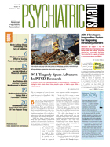Is a personality disorder "the way you are" or a condition you "have"?
A little bit of both, say experts in personality pathology. Traits of personality, good and bad, are liable to be more or less stable and consistent over time, an expression of the "way a person is."
But the degree of impairment that pathological traits may cause can fluctuate as symptoms wax and wane and may vary from patient to patient, a reflection of "a condition one has," which—like high blood pressure—may vary at different developmental periods of life and in response to varying life circumstances and environmental stressors.
This dual understanding of personality as a stable construct and of personality pathology as varying in degree of impairment is reflected in newly proposed criteria for personality disorders (PD), a hybrid dimensional-categorical model for personality assessment and PD diagnosis now being field-tested for inclusion in
DSM-5 (see Highlights of Proposed Changes to Personality Disorder Criteria).
The proposed criteria describe six specific personality disorder types—antisocial, avoidant, borderline, narcissistic, obsessive-compulsive, and schizotypal—as well as an additional diagnosis for personality disorder trait specified (PDTS). All of these diagnoses require impairment in personality functioning and the appearance of pathological personality traits in one or more trait domains.
The new criteria are being tested in field trials in large, academic medical institutions and a wide selection of clinical practice settings, such as solo and small-group practices. In addition to testing the reliability, feasibility, and perceived clinical utility of the new criteria, the field trials will help establish scoring algorithms for the individual criteria and the disorders themselves.
Members of the DSM-5 Personality and Personality Disorders Work Group said that the new system will be clinician friendly and designed to better "fit" the actual presentation of personality and personality disorders in a clinical setting.
Most importantly, the new criteria offer alternatives to the clinical thresholds of DSM-IV's 10-category diagnostic system.
"One of the problems with DSM-IV and these diagnostic thresholds was that it presumed that if an individual met four of the criteria for a diagnosis that required five, then the individual didn't have the disorder," said Andrew Skodol, M.D., chair of the Personality and Personality Disorders Work Group, in an interview with Psychiatric News. "But in fact, no clinician really believes that to be the case. Most clinicians would look at the person meeting four criteria as having a slightly milder version of the disorder.
"DSM-IV was an attempt to capture in an all-or-nothing way what most people believe is more of a continuous variation in personality pathology," Skodol said. "That's what our new proposed criteria seek to reflect."
So how would the system work?
APA President and work group member John Oldham, M.D., explained that two sets of criteria are used to make a diagnosis of personality disorder: a measure of level of impairment in personality function (criterion A) and the presence of at least one pathological personality trait domain (criterion B).
On the basis of patient self-report and clinical presentation, a clinician would begin to make the assessment of personality disorder by using the Level of Personality Functioning Scale, a five-point rating scale (0 representing "no impairment" and 4 representing "extreme impairment") for the patient's level of impairment in two domains of personality function—"self" and "interpersonal" (see
How Does Personality Function Scale Work?).
The presence of pathological personality traits would be assessed using criterion B, which outlines five broad personality trait domains (negative affectivity, detachment, antagonism, disinhibition vs. compulsivity, and psychoticism), as well as component trait facets (for example, impulsivity and rigid perfectionism).
Oldham said an assessment can "telescope" the clinician's attention from a global rating of the overall severity of impairment in personality functioning, through increasing degrees of detail and specificity in describing personality psychopathology that can be pursued depending on constraints of time and information and on expertise.
Based on the two sets of criteria, the clinician determines if the patient meets one of the six PD types. If not, and the patient nevertheless has significant impairment and at least one pathological personality trait, then a diagnosis of PD-trait specified can be made. The latter designation replaces personality disorder not otherwise specified (NOS) in DSM-IV.
Oldham said PD-NOS has been a commonly used diagnosis, but has often been used incorrectly to mean "mixed" personality disorder. "Even when used correctly, it has been sort of a wastebasket category for patients judged to have a personality disorder but who don't fit any of the categories," he said.
With the diagnosis of PD-trait specified and the use of criterion B, the specific personality features can be recorded in the chart and serve as a focus of clinical attention.
Oldham and Skodol said that the system will require some training, but that once clinicians familiarize themselves with the criteria, they will find the system easier to use than DSM-IV, more intuitive, and more reliably concordant with the clinical presentation of patients with personality disorders.
They urged clinicians to go to the DSM-5 Web site to learn about the proposed system.
"Almost everyone is going to say it is too complicated because it looks different and unfamiliar," Oldham told Psychiatric News. "But I am very confident that once people get familiar with it, they will like it. And that is in fact what we have found in field trials—the people who have used it say it is better and simpler to use than DSM-IV."
